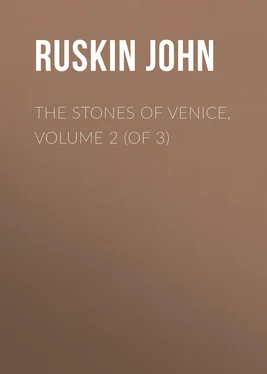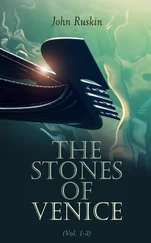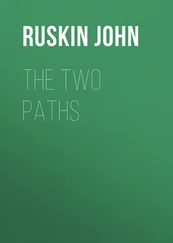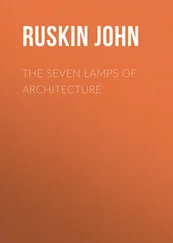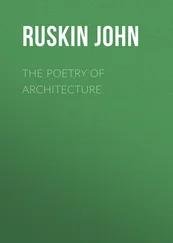John Ruskin - The Stones of Venice, Volume 2 (of 3)
Здесь есть возможность читать онлайн «John Ruskin - The Stones of Venice, Volume 2 (of 3)» — ознакомительный отрывок электронной книги совершенно бесплатно, а после прочтения отрывка купить полную версию. В некоторых случаях можно слушать аудио, скачать через торрент в формате fb2 и присутствует краткое содержание. Жанр: foreign_antique, foreign_home, architecture_book, literature_19, visual_arts, на английском языке. Описание произведения, (предисловие) а так же отзывы посетителей доступны на портале библиотеки ЛибКат.
- Название:The Stones of Venice, Volume 2 (of 3)
- Автор:
- Жанр:
- Год:неизвестен
- ISBN:нет данных
- Рейтинг книги:5 / 5. Голосов: 1
-
Избранное:Добавить в избранное
- Отзывы:
-
Ваша оценка:
- 100
- 1
- 2
- 3
- 4
- 5
The Stones of Venice, Volume 2 (of 3): краткое содержание, описание и аннотация
Предлагаем к чтению аннотацию, описание, краткое содержание или предисловие (зависит от того, что написал сам автор книги «The Stones of Venice, Volume 2 (of 3)»). Если вы не нашли необходимую информацию о книге — напишите в комментариях, мы постараемся отыскать её.
The Stones of Venice, Volume 2 (of 3) — читать онлайн ознакомительный отрывок
Ниже представлен текст книги, разбитый по страницам. Система сохранения места последней прочитанной страницы, позволяет с удобством читать онлайн бесплатно книгу «The Stones of Venice, Volume 2 (of 3)», без необходимости каждый раз заново искать на чём Вы остановились. Поставьте закладку, и сможете в любой момент перейти на страницу, на которой закончили чтение.
Интервал:
Закладка:
That we may not enter the church out of the midst of the horror of this, let us turn aside under the portico which looks towards the sea, and passing round within the two massive pillars brought from St. Jean d’Acre, we shall find the gate of the Baptistery; let us enter there. The heavy door closes behind us instantly, and the light, and the turbulence of the Piazzetta, are together shut out by it.
§ XVI. We are in a low vaulted room; vaulted, not with arches, but with small cupolas starred with gold, and chequered with gloomy figures: in the centre is a bronze font charged with rich bas-reliefs, a small figure of the Baptist standing above it in a single ray of light that glances across the narrow room, dying as it falls from a window high in the wall, and the first thing that it strikes, and the only thing that it strikes brightly, is a tomb. We hardly know if it be a tomb indeed; for it is like a narrow couch set beside the window, low-roofed and curtained, so that it might seem, but that it has some height above the pavement, to have been drawn towards the window, that the sleeper might be wakened early;—only there are two angels who have drawn the curtain back, and are looking down upon him. Let us look also, and thank that gentle light that rests upon his forehead for ever, and dies away upon his breast.
The face is of a man in middle life, but there are two deep furrows right across the forehead, dividing it like the foundations of a tower: the height of it above is bound by the fillet of the ducal cap. The rest of the features are singularly small and delicate, the lips sharp, perhaps the sharpness of death being added to that of the natural lines; but there is a sweet smile upon them, and a deep serenity upon the whole countenance. The roof of the canopy above has been blue, filled with stars; beneath, in the centre of the tomb on which the figure rests, is a seated figure of the Virgin, and the border of it all around is of flowers and soft leaves, growing rich and deep, as if in a field in summer.
It is the Doge Andrea Dandolo, a man early great among the great of Venice; and early lost. She chose him for her king in his 36th year; he died ten years later, leaving behind him that history to which we owe half of what we know of her former fortunes.
§ XVII. Look round at the room in which he lies. The floor of it is of rich mosaic, encompassed by a low seat of red marble, and its walls are of alabaster, but worn and shattered, and darkly stained with age, almost a ruin,—in places the slabs of marble have fallen away altogether, and the rugged brickwork is seen through the rents, but all beautiful; the ravaging fissures fretting their way among the islands and channelled zones of the alabaster, and the time-stains on its translucent masses darkened into fields of rich golden brown, like the color of seaweed when the sun strikes on it through deep sea. The light fades away into the recess of the chamber towards the altar, and the eye can hardly trace the lines of the bas-relief behind it of the baptism of Christ: but on the vaulting of the roof the figures are distinct, and there are seen upon it two great circles, one surrounded by the “Principalities and powers in heavenly places,” of which Milton has expressed the ancient division in the single massy line,
“Thrones, Dominations, Princedoms, Virtues, Powers,”
and around the other, the Apostles; Christ the centre of both; and upon the walls, again and again repeated, the gaunt figure of the Baptist, in every circumstance of his life and death; and the streams of the Jordan running down between their cloven rocks; the axe laid to the root of a fruitless tree that springs upon their shore. “Every tree that bringeth not forth good fruit shall be hewn down, and cast into the fire.” Yes, verily: to be baptized with fire, or to be cast therein; it is the choice set before all men. The march-notes still murmur through the grated window, and mingle with the sounding in our ears of the sentence of judgment, which the old Greek has written on that Baptistery wall. Venice has made her choice.
§ XVIII. He who lies under that stony canopy would have taught her another choice, in his day, if she would have listened to him; but he and his counsels have long been forgotten by her, and the dust lies upon his lips.
Through the heavy door whose bronze network closes the place of his rest, let us enter the church itself. It is lost in still deeper twilight, to which the eye must be accustomed for some moments before the form of the building can be traced; and then there opens before us a vast cave, hewn out into the form of a Cross, and divided into shadowy aisles by many pillars. Round the domes of its roof the light enters only through narrow apertures like large stars; and here and there a ray or two from some far away casement wanders into the darkness, and casts a narrow phosphoric stream upon the waves of marble that heave and fall in a thousand colors along the floor. What else there is of light is from torches, or silver lamps, burning ceaselessly in the recesses of the chapels; the roof sheeted with gold, and the polished walls covered with alabaster, give back at every curve and angle some feeble gleaming to the flames; and the glories round the heads of the sculptured saints flash out upon us as we pass them, and sink again into the gloom. Under foot and over head, a continual succession of crowded imagery, one picture passing into another, as in a dream; forms beautiful and terrible mixed together; dragons and serpents, and ravening beasts of prey, and graceful birds that in the midst of them drink from running fountains and feed from vases of crystal; the passions and the pleasures of human life symbolized together, and the mystery of its redemption; for the mazes of interwoven lines and changeful pictures lead always at last to the Cross, lifted and carved in every place and upon every stone; sometimes with the serpent of eternity wrapt round it, sometimes with doves beneath its arms, and sweet herbage growing forth from its feet; but conspicuous most of all on the great rood that crosses the church before the altar, raised in bright blazonry against the shadow of the apse. And although in the recesses of the aisles and chapels, when the mist of the incense hangs heavily, we may see continually a figure traced in faint lines upon their marble, a woman standing with her eyes raised to heaven, and the inscription above her, “Mother of God,” she is not here the presiding deity. It is the Cross that is first seen, and always, burning in the centre of the temple; and every dome and hollow of its roof has the figure of Christ in the utmost height of it, raised in power, or returning in judgment.
§ XIX. Nor is this interior without effect on the minds of the people. At every hour of the day there are groups collected before the various shrines, and solitary worshippers scattered through the darker places of the church, evidently in prayer both deep and reverent, and, for the most part, profoundly sorrowful. The devotees at the greater number of the renowned shrines of Romanism may be seen murmuring their appointed prayers with wandering eyes and unengaged gestures; but the step of the stranger does not disturb those who kneel on the pavement of St. Mark’s; and hardly a moment passes, from early morning to sunset, in which we may not see some half-veiled figure enter beneath the Arabian porch, cast itself into long abasement on the floor of the temple, and then rising slowly with more confirmed step, and with a passionate kiss and clasp of the arms given to the feet of the crucifix, by which the lamps burn always in the northern aisle, leave the church, as if comforted.
§ XX. But we must not hastily conclude from this that the nobler characters of the building have at present any influence in fostering a devotional spirit. There is distress enough in Venice to bring many to their knees, without excitement from external imagery; and whatever there may be in the temper of the worship offered in St. Mark’s more than can be accounted for by reference to the unhappy circumstances of the city, is assuredly not owing either to the beauty of its architecture or to the impressiveness of the Scripture histories embodied in its mosaics. That it has a peculiar effect, however slight, on the popular mind, may perhaps be safely conjectured from the number of worshippers which it attracts, while the churches of St. Paul and the Frari, larger in size and more central in position, are left comparatively empty. 28But this effect is altogether to be ascribed to its richer assemblage of those sources of influence which address themselves to the commonest instincts of the human mind, and which, in all ages and countries, have been more or less employed in the support of superstition. Darkness and mystery; confused recesses of building; artificial light employed in small quantity, but maintained with a constancy which seems to give it a kind of sacredness; preciousness of material easily comprehended by the vulgar eye; close air loaded with a sweet and peculiar odor associated only with religious services, solemn music, and tangible idols or images having popular legends attached to them,—these, the stage properties of superstition, which have been from the beginning of the world, and must be to the end of it, employed by all nations, whether openly savage or nominally civilized, to produce a false awe in minds incapable of apprehending the true nature of the Deity, are assembled in St. Mark’s to a degree, as far as I know, unexampled in any other European church. The arts of the Magus and the Brahmin are exhausted in the animation of a paralyzed Christianity; and the popular sentiment which these arts excite is to be regarded by us with no more respect than we should have considered ourselves justified in rendering to the devotion of the worshippers at Eleusis, Ellora, or Edfou. 29
Читать дальшеИнтервал:
Закладка:
Похожие книги на «The Stones of Venice, Volume 2 (of 3)»
Представляем Вашему вниманию похожие книги на «The Stones of Venice, Volume 2 (of 3)» списком для выбора. Мы отобрали схожую по названию и смыслу литературу в надежде предоставить читателям больше вариантов отыскать новые, интересные, ещё непрочитанные произведения.
Обсуждение, отзывы о книге «The Stones of Venice, Volume 2 (of 3)» и просто собственные мнения читателей. Оставьте ваши комментарии, напишите, что Вы думаете о произведении, его смысле или главных героях. Укажите что конкретно понравилось, а что нет, и почему Вы так считаете.
